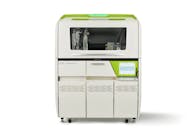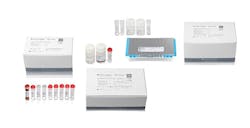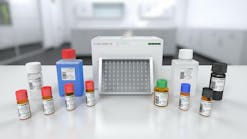Despite great strides in medical practice over the last 150 years, sepsis (bloodstream infections coupled with an excessive inflammatory response) remains a very significant problem. In fact, it’s estimated that globally, sepsis is more common than heart attack and claims more lives than any one form of cancer. In the United States alone, severe sepsis has an estimated incidence of 300 per 100,000 population (.3 percent), with approximately half of these cases occurring outside of ICU settings and up to one-quarter of patients with severe sepsis dying as a result.1 In worst cases, the time of untreated disease progression from detection to fatality can be as little as a few hours. As if these statistics weren’t sobering enough, the incidence of sepsis even in developed countries is observed to be increasing.2
Clearly, this is a medical condition for which more effective diagnosis is needed with both rapid test speed (short turnaround time or TAT) and extreme sensitivity. (Sepsis doesn’t necessarily equate to high bloodstream pathogen titers; more than half of adults with sepsis have less than one cfu/ml of associated pathogen in peripheral blood.3) Finally, identification of the causative pathogen is essential in selecting appropriate antibiotic therapy as part of the treatment. These requirements make molecular diagnostics (MDx) an attractive approach to consider for sepsis diagnostics.
The conventional non-MDx workflow for sepsis diagnosis is blood culture (BC) (with various approaches to number and types of BC bottles to collect, in an effort to not be misled by insignificant transient bacteremias or sampling contamination), followed by traditional microbiology workup (plate culture for identification and antibiotic susceptibility determination) on positive BCs. The major downside to this approach is that it can take several days to perform.
There are three common approaches to applying MDx to this workflow in an effort to speed up the process: direct MDx on peripheral blood (pre-BC); MDx on samples from positive BC; and MDx on individual colonies on plate culture derived from a positive BC. Of these, direct MDx on peripheral blood sample offers by far the largest potential saving in critical time to diagnosis and will be our main focus.
MDx on peripheral blood
At first glance, this might seem like a simple approach. Get a blood sample, extract nucleic acids, and run some sort of PCR, and you’re done, right? Unfortunately it’s not that easy; let’s consider what some of the technical challenges are.
First, there’s the issue of low pathogen titer. Most nucleic acid extraction methods take input volumes of 1 ml raw sample or less (in fact, many work on 0.5 ml or less). Sampling statistics aren’t working in our favor here, either; if a specimen has 1 cfu/ml, we would actually need to sample almost 3 ml to achieve a 95 percent probability of getting that one colony. At 0.5 ml per sample, we’d need to take six samples to get this confidence level—and bear in mind that most adult sepsis cases don’t even reach 1 cfu/ml. The bottom line: sample size is an immediate hurdle to direct MDx sepsis diagnosis. Any method looking to do this will probably need to sample on the order of 10 ml of peripheral blood, and have some sort of selective enrichment process to collect the bacteria into a workable portion for nucleic acid extraction. Fortunately, this hurdle can be handled by a variety of methods, such as selective centrifugation or microfluidic sorting; if you look to do direct sepsis MDx, expect to have to do something like that.
Once we have a nucleic acid extract from a suitably large peripheral blood sample, our second challenge is “What do we look for?” In terms of causative organisms, the majority of sepsis cases arise from a handful of organisms; however, it’s a very “long tail” distribution with very many organisms contributing small numbers of cases that we’d rather not overlook. If we restrict ourselves to looking for bacterial pathogens, there is at least one molecular target in common to all of them, the 16S ribosomal RNA (rRNA) gene. Genetic pressure has maintained enough conservation in this sequence to allow for the design of PCR primer sets which can be very nearly “pan-species,” so that a single PCR reaction can confirm or deny the presence of bacterial DNA in our extracted sample. This sounds at first to be a good approach; and indeed, several commercial systems take this approach to at least rule out sepsis when bacterial DNA is not detected. In the event that DNA is detected, however, a positive 16S rRNA result is not tremendously helpful; without knowing the organism species (singular or in some cases, plural), appropriate antibiotic therapy choices cannot be informed and we have limited benefit toward the initiation of suitable therapy. Ideally then, we also wish our MDx method to provide pathogen species identification.
Our 16S rRNA gene can still be used for this, if we’re willing to sequence internal “hypervariable” regions inside the conserved flanking sequences and compare these sequences against known species 16S libraries. This approach is both accurate and broad spectrum, although it is neither fast nor readily amenable to high throughput and automation. Despite these limitations, this method has been in use in some clinical settings for some time now, and it can be a powerful tool in the early detection and appropriate classification of sepsis cause and treatment selection.
Peripheral blood, multiplex methods
Other methods approach this by employing multiplex methods. The reader will hopefully recall from earlier installments of “The Primer” that this is the simultaneous use of multiple target-specific (in this case, likely pathogen species) primer sets within a single PCR reaction, with some form of downstream analysis such as amplicon size, melt temperature, sequence-specific array capture, or distinctive fluorophore labelling used to identify which species-specific amplicon (or amplicons) are generated from the sample. Multiple commercial methods exist which employ variations on this approach, which generally has rapid TAT coupled with good sensitivity and specificity, at the cost of less than complete coverage of potential causal organisms. If such a method is inexpensive and provides answers in a sizeable proportion of cases, while the remaining cases continue to be analyzed by traditional microbiological methods, then it has clear benefits to the “average” patient even with these shortcomings.
One powerful bit of information from the classical microbiological workflow in sepsis is the antibiotic resistance profile of the infecting organism. While empirical data on the likely antibiotic susceptibility of an identified organism in a particular geographic setting is a good start for selecting antibiotic therapy, changes in antibiotic resistance profiles of various pathogen species do occur, and, given the potential rapidity of disease progression, waiting to see if a first-choice antibiotic is working may not be in the patient’s best interest. By the time an outlier with unexpected resistance is recognized, it may be too late.
Some MDx methods for sepsis determination attempt to address this by including detection of common antibiotic resistance markers such as MecA, VanA, or various penicillin binding proteins (PBPs). These approaches generally share three common weakness, however.
- First, there are a large number of genetic variants of these resistance genes, making it essentially impossible to screen for all of them. Compounding this, they tend to have relatively quick genetic drift, meaning the common versions of one of these genes today may not be the common form in a year, leading to potential false negative results. Addressing this through constant surveillance and revision of the suitable target primer sets for PCR-based detection approaches is costly and cumbersome from an assay validation and regulatory perspective.
- Second, even if a particular antibiotic resistance marker is detected by MDx approaches, that is not strictly equivalent to meeting clinical guidelines for antibiotic resistance, which includes dose response considerations (“breakpoints”). That is, an organism may have the resistance gene, yet express it poorly or at low levels, and thus not display the associated resistance as formally defined.
- Third, most MDx methods utilized in the sepsis context don’t have a way to unequivocally associate a detected antibiotic resistance marker with the bacterial species if more than one species is present (in blood culture terms, a mixed infection). This last problem is perhaps best illustrated in the context of methicillin resistance associated with MecA; peripheral blood collected by venipuncture is sometimes contaminated with coagulase-negative Staphylococcus such as S. epidermidis, which in turn frequently carries the MecA gene. If a sample is detected by MDX as positive for S. epidermidis, S. aureus, and MecA, does the patient have a MRSA infection—or an easily treatable non-MRSA, with contamination?
MDx further “down the path”
As opposed to doing MDX direct from peripheral blood for sepsis, application of MDx further down the diagnostic path helps to resolve some of these issues, albeit at a cost of lost TAT improvements. Sampling of blood culture bottles either before or after they have detected positive for bacterial growth by conventional methods allows us to avoid the low target titer problem; rather than < 1 cfu/ml of the original sample, a positive inoculated BC bottle will have large pathogen titers suitable for reliable collection and detection in more manageable sample sizes (0.5 ml or less). Application of MDx at this stage can still save 24 to 48 hours needed for traditional plating and colony growth, enumeration, and antibiotic susceptibility testing. As such, this is a viable compromise solution, and several commercial systems take this approach.
Finally, if molecular detection of specific antibiotic resistance markers is an acceptable surrogate of phenotypic antibiotic resistance determination, but there’s a desire to be able to definitively assign detected markers to a specific species in a potentially mixed sample, then MDx may be applied subsequent to a positive BC being plated. Selection of individual colonies from such a plate ensures that any detected resistance markers are associated with the identified colony species, and may be done with exceptionally rapid and crude nucleic acid extraction techniques (such as heat lysis without further purification) followed by rapid PCR methods, which can thus still save a day or more compared to allowing colony growth in presence of antibiotic test materials required for accurate determination of phenotypic breakpoints. (Note this is also the point in the traditional workflow where mass spectrometry is most commonly applied, as it can provide extremely rapid, accurate, and inexpensive species identification minutes from isolated colony to identification, although currently lacking antibiotic susceptibility data.)
Molecular diagnostics offers hope for improved treatment of a common and serious condition; however, this hope is not without complexities in actual realization. Multiple MDx approaches to sepsis diagnosis are available in various markets, and it is hoped that the above consideration of the challenges each of these approaches in general face and the compromises they make in providing a solution will help to guide selection of the method(s) most appropriate to the reader’s setting.
REFERENCES
- Mayr FB, Yende S, Angus DC. Epidemiology of severe sepsis. Virulence 2014;5(1):4–11.
Martin GS. Sepsis, severe sepsis and septic shock: changes in incidence, pathogens and outcomes. Expert Review of Anti-infective Therapy. 2012;10(6):701–706. - Towns ML, Jarvis WR, Hsueh PR. Guidelines on blood cultures. J Microbiol Immunol Infect. 2010;43(4):347-349.
John Brunstein, PhD, is a member of the MLO Editorial Advisory Board. He serves as President and Chief Science Officer for British Columbia-based PathoID, Inc., which provides consulting for development and validation of molecular assays.





